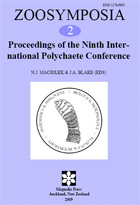Abstract
Polynoid polychaetes are common marine invertebrates worldwide that are characterized by bearing series of paired elytra attached to dorsal prominences (the elytrophores) arising from the notopodia, and whose dorsal surface is usually ornamented with different papillae (usually thought to be sensory organs). Upon stimulation, some species of the sub-family Polynoinae are able to emit light flashes from the ventral epithelium of the elytra. This bioluminescence originates in a protein called polynoidin, and seems to be induced by the destruction of the electrochemical coupling between body and elytra when the latter are detached. However, the elytral structure, as well as the function of the papillae and tubercles in relation to the bioluminescence is poorly known. In this paper, we report on the elytral morphology of two “luminescent” and two “non-luminescent” (Nicol 1953) species from the White and Mediterranean Seas. In both polynoid types, the elytral tubercles are formed by a layer of hard, non-organized, autofluorescent tissue, apparently filled by expansions protruding from cells forming a distinct subjacent layer. Our study allowed us to suggest that the luminescent protein is located in the cells of the basal layer, while the tubercles may act as lenses helping in the light flash transfer towards the exterior. The reasons why the studied species are or are not bioluminescent are discussed.

